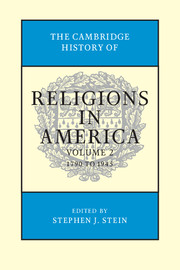Book contents
- Frontmatter
- Contents
- Contributors
- Editor's Introduction
- SECTION I RELIGION IN NORTH AMERICA
- SECTION II RELIGIONS IN THE NEW NATION, 1790–1865
- SECTION III CHANGING RELIGIOUS REALITIES
- SECTION IV RELIGIOUS RESPONSES TO MODERN LIFE AND THOUGHT
- 21 Religion and Immigration, 1865–1945
- 22 Religion and the Modern City, 1865–1945
- 23 Religious Responses to Industrialization, 1865–1945
- 24 Religious Responses to Modern Science, 1865–1945
- 25 Religious Responses to Philosophy in America, 1865–1945
- 26 Fundamentalism
- 27 Religiously Informed Social Reform and Reaction in the Era of the Great Depression
- 28 Nativism from the New Republic to the Cold War
- 29 Between God and Caesar: World War I and America's Religious Communities
- 30 World War II and America's Religious Communities
- SECTION V COMPARATIVE ESSAYS
- SECTION VI RELIGION AND DIVERSE AREAS
- Index
- References
21 - Religion and Immigration, 1865–1945
from SECTION IV - RELIGIOUS RESPONSES TO MODERN LIFE AND THOUGHT
Published online by Cambridge University Press: 28 July 2012
- Frontmatter
- Contents
- Contributors
- Editor's Introduction
- SECTION I RELIGION IN NORTH AMERICA
- SECTION II RELIGIONS IN THE NEW NATION, 1790–1865
- SECTION III CHANGING RELIGIOUS REALITIES
- SECTION IV RELIGIOUS RESPONSES TO MODERN LIFE AND THOUGHT
- 21 Religion and Immigration, 1865–1945
- 22 Religion and the Modern City, 1865–1945
- 23 Religious Responses to Industrialization, 1865–1945
- 24 Religious Responses to Modern Science, 1865–1945
- 25 Religious Responses to Philosophy in America, 1865–1945
- 26 Fundamentalism
- 27 Religiously Informed Social Reform and Reaction in the Era of the Great Depression
- 28 Nativism from the New Republic to the Cold War
- 29 Between God and Caesar: World War I and America's Religious Communities
- 30 World War II and America's Religious Communities
- SECTION V COMPARATIVE ESSAYS
- SECTION VI RELIGION AND DIVERSE AREAS
- Index
- References
Summary
During the last quarter of the nineteenth century, the United States underwent profound and at times traumatic social change occasioned by the processes of industrialization, urbanization, and immigration. The United States was transformed from a rural, agricultural nation into an urban, industrial nation. In 1899, industrial exports surpassed agricultural exports for the first time, and by 1920, more Americans lived in urban settings than in rural. Fueling this transformation were the millions of immigrants who arrived to become the raw materials for this expansion. The massive influx of immigrants presented the churches in the United States with enormous pastoral, physical, and human challenges, and the churches responded in a variety of ways.
Immigration, which had slowed during the first several years of the Civil War, picked up again in 1864 and exploded by the end of the nineteenth century. The immigration immediately following the war was similar to prewar immigration with the largest groups still coming from Germany, Ireland, and Great Britain. By 1910 the face of immigration had dramatically changed. Immigrants now poured in from Italy, Russia, and Austro-Hungary, which included Austrians, Hungarians, Galician Poles, Czechs, Slovaks, Rusins, Ukrainians, Slovenes, Croatians, and Serbians. Significant numbers also came from the Scandinavian countries: Sweden, Denmark, and Norway. The unsettled and changing economic conditions in Eastern, Southern, and Central Europe led to a new immigration. The disastrous Kulturkampf in German-controlled lands and the brutal pogroms directed against Russian Jews sent many more.
- Type
- Chapter
- Information
- The Cambridge History of Religions in America , pp. 457 - 478Publisher: Cambridge University PressPrint publication year: 2000



